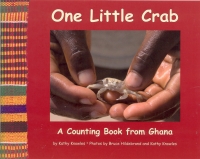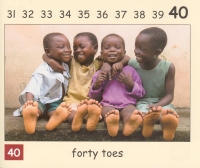| ________________
CM . . .
. Volume XIII Number 2 . . . .September 15, 2006
One Little Crab: A Counting Book from Ghana is simply a superb counting book. While focusing on the numbers from one to 10, the book also “counts” to 100, by tens. Each of the first 10 numbers gets its own page, and, following that, each page deals with a ten. A number line, which has the focused-upon number presented in bolded, larger print, appears at the top of each page while, at the bottom of the page can be found the appropriate number and the brief text, such as “7 seven fish” or “80 eighty beans.” In between are Hildebrand’s and Knowles’ full colour photos which are doubly excellent. With one small exception, the objects to be counted are clearly delineated, and the objects for the numbers from 20 through100 are generally grouped to facilitate counting. The only photograph in the 1-10 section that might give young children some difficulties is “eight pawpaws.” Although the photo does, indeed, have the required number of fruits, the photograph, shot from above, overlaps the individual pawpaws. Additionally, the photo has been cropped so that some of the fruits are incomplete (and to the child still dealing with Piagetian conservation tasks, “not there.”). North American children will recognize
Profits from the sale of this book will support the Osu Children’s Library Fund, “an organization that promotes the joy of reading for al in Africa.” See www.osuchildrenslibraryfund.ca for more information.
Highly Recommended. Dave Jenkinson teaches courses in children’s and YA literature at the Faculty of Education, the University of Manitoba.
To comment
on this title or this review, send mail to cm@umanitoba.ca.
Copyright © the Manitoba Library Association. Reproduction for personal
use is permitted only if this copyright notice is maintained. Any
other reproduction is prohibited without permission.
NEXT REVIEW |
TABLE OF CONTENTS FOR THIS ISSUE
- September 15, 2006.
AUTHORS |
TITLES |
MEDIA REVIEWS |
PROFILES |
BACK ISSUES |
SEARCH |
CMARCHIVE |
HOME |

 some familiar counting “items,” such as the “two dogs,” the “nine coloured pencils” and the “thirty eggs,” but some objects, like “calabashes” and “pawpaws” will likely be new. People’s dress and some of the pictures’ backgrounds will remind young readers/listeners that the setting is elsewhere. The four children used to illustrate “forty toes” are just adorable. At the conclusion of
some familiar counting “items,” such as the “two dogs,” the “nine coloured pencils” and the “thirty eggs,” but some objects, like “calabashes” and “pawpaws” will likely be new. People’s dress and some of the pictures’ backgrounds will remind young readers/listeners that the setting is elsewhere. The four children used to illustrate “forty toes” are just adorable. At the conclusion of